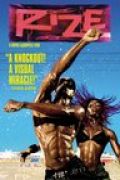
Directed by
David LaChapelle
86 minutes
Rated M
Reviewed by
Andrew Lee

Rize
Synopsis: Focusing on a group of dancers in South Central LA, Rize documents the evolution of a street dance phenomenon known as "Krumping".Ever heard of Krumping? Nor had I. Fortunately, fashion photographer/music video director David LaChapelle decided to make a documentary about this hyper-kinetic dance style. And hyper-kinetic isn't an overstatement, indeed the film opens with a disclaimer that none of the footage has been sped up. The next scenes are instructive: Footage from the Watts riots in 1965, followed by the 1992 LA riots. Then a girl bent over a car as two of her friends mock-beat her, LAPD style. The beating is rhythmic and swiftly evolves into the three girls dancing together as mock violence becomes a celebration of life. Krumping, described by one dancer as "Ghetto Ballet", and its power to transform is the core of this film.
Taking us into the lives of a number of the dancers, Rize chronicles the history of this hip-hop dance movement from its beginnings in clowning to the present day incarnation called Krumping. You read that right, clowning. The main character of the piece is an amazing guy named Tommy the Clown. Fresh out of jail and needing something to do, he started clowning at children's parties as Tommy the Hip-Hop Clown. He had the kids dancing as part of his act and soon clowning groups started forming. They painted their faces and danced to entertain. Tommy started an academy for clowning and took in kids and taught them. Their dance evolved from this, and then the split came. The students left their teacher. Krumping was born, and the Clowns and Krumpers now have an annual "Battle Zone" dance-off. People dance with painted faces, contorting their bodies at tremendous speed and constantly evolving the dance. Miss a day and you'll be behind the times, observes one dancer. Drawing a lineage back to African tribal dance, and the relevance of it to the dancers today, the film also makes a fascinating observation. The dance itself is what drives the dancers; it fills a spiritual need. And that is an idea that's worth thinking about. A dance movement started by a guy who clowns at children's parties has evolved into something that's transforming communities. Many of the dancers observe that if it wasn't for Krumping, they'd be dealing drugs on street corners, gunning down rival gang members or getting themselves killed.
LaChapelle's background in photography (he is widely ranked as one of the ten best photographers in the world) shows, the film is gorgeous to look at, even when using video it still maintains an arresting framing. Yet what starts off feeling like a one-note extended music video (LaChapelle was introduced to krumping on the set of Christina Aguilera's Dirrty video, which he also directed) becomes an inspiring story of a dance movement that is also an agent of social change. It's occasionally over-earnest, the dance sequences, ironically, sometimes slow the pacing, but you can forgive all that because the enthusiasm and joy of this dance that LaChapelle so effectively brings to the screen is irresistibly infectious.

Want more about this film?


Want something different?




